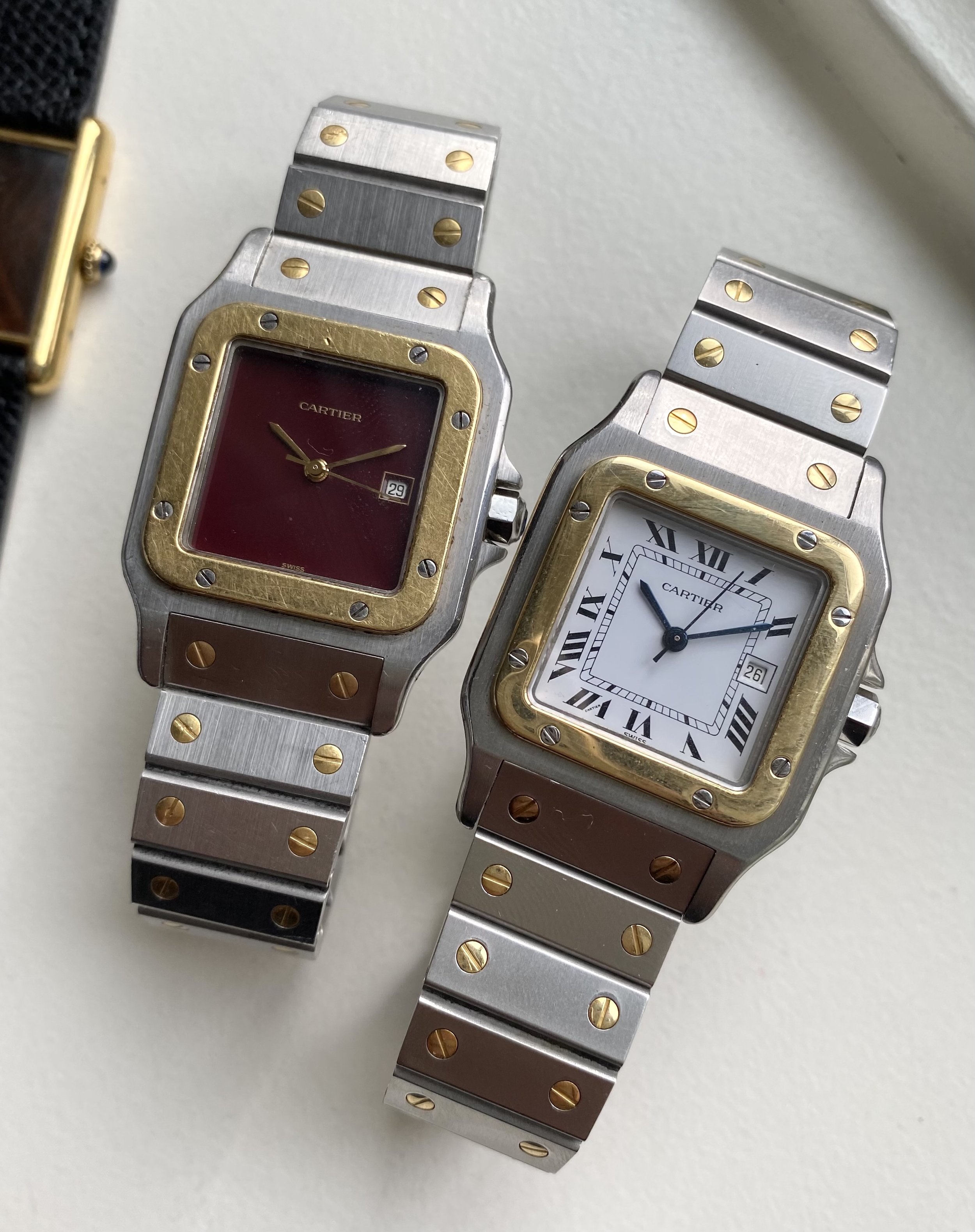One of the Fastest Growing Markets Right Now: Cartier Santos
Jacob Heffner (@pinaplwtchs) and Danny team up to talk vintage Cartier Santos.
Over the past year or so, the Cartier brand has exploded in popularity. From the Crash, to the Must de Tank, their watches have been featured in the pop culture limelight.
This added attention and market demand, especially for vintage pieces, has caused an expected price increase across the board.
The Santos, however, is a watch that I’ve noticed some insane growth in over the past couple months. I mean, these trends are taking hold right before our eyes, and collectors are about to watch 1970s/1980s Santos watches quickly reach a much less-affordable level.
To help us discuss this is Josh Cameron and Danny Matatov, good friends who run DVW. My friend Time Is Universal, a Cartier collector and photographer, also helped direct the photography behind this article with some incredible shots of grail-level Santos pieces. In other words, this is our most cohesive article to date.
Santos Background and History of Reinterpretation
Beginning in the mid-1970s, Cartier underwent and adopted some changes to their brand. This is especially evident within their watch line.
In terms of watches, Cartier went from producing very few (in some cases, dozens) of watches a year, to having mass market, consumer lines.
Too many articles simply grace over this fact of Cartier history, yet it’s too important to neglect.
In 1964, the Cartier family sold the different Cartier branches following the death of Pierre Cartier. Between 1972 and 1976, Cartier Paris, London, and New York were acquired by then brand president Robert Hocq and a group of investors. Under collective ownership, the purchase of all three Cartier locations ‘reunited’ the brand in a sense, forming a more modern Cartier Worldwide brand.
During this time of reorganization, the “Must de Cartier” line was introduced. It aimed to provide a more accessible Cartier product while simultaneously altering brand perception ever so slightly. Cartier, once the ‘king of jewelers, jeweler for kings’ was now offering plated timepieces, and better yet, steel watches.
One of Cartier’s most historic lines, the Santos, benefited from this ‘rebranding’ of offering more consumer/retail friendly timepieces.
To understand why the brand went from working exclusively with precious metals to offering a steel Santos, we must first understand what was going on in the watch world at this time.
Steel was in vogue, The Royal Oak proved that a Hail Mary attempt of popularizing industrial steel design as luxurious was successful, an idea that, like quartz, forever changed the watch world. Offering a steel Santos was Cartier’s response to this phenomenon, and in a sense, these watches are directly connected to this important history.
Image courtesy @willandtime on Instagram.
References and Examples
Two sizes of neo-vintage Santos exist here - the 29mm and 24mm examples.
Some popular references include the 2960 (all steel), 2961 (two tone), and 0902/0901 (respectively two tone and steel in the smaller size). Within these references exist multiple dial iterations. There are also more rare solid gold examples in the same sizes, and some of these have very unique dial configurations (that incorporate diamonds in some cases).
Most notably, there are red, gray, and traditional white ‘porcelain’ dial options for these timepieces. Independent of case material, these dials are found across the board. Some rumor that the burgundy dial Santos was an anniversary piece (burgundy being the brand’s color) celebrating 75 years of the Santos. The crown on these watches feature a ruby cabochon as opposed to the more traditional sapphire. Others refute these anniversary claims stating these dials are a product of the ‘Must’ era where Santos pieces featured the same lacquered dials as their Must Tank cousins.
One interesting aspect of collectability are the bezels on these watches. Some examples came with factory brushed dials, most typically on the burgundy dial variants. Polished bezels on these are marks of refinishing and thus are less desirable.
I’d be remiss to not mention the Santos bracelets. Personally, I was surprised when getting hands on how well they are constructed, especially considering their age. A Rolex bracelet from the same era feels akin to that on a Seiko 5, yet the Santos bracelet feels sturdy and firm with a healthy presence.
Bracelets with their factory finishing still present play with the light in a way that resembles a Royal Oak. Now, while some might scoff at my comparison of a Santos to a RO, it isn’t entirely inappropriate in this sense. We must hark back to the point of Cartier responding to the industrial luxury movement. The bracelet design best reflects this response, especially when one considers the screws, articulation, and integrated design.
My Santos is really just a simple steel timepiece created by the greatest designer in watches with a level of finishing that reflects a Cartier response to the steel luxury movement. Oh, and its easy to service with a reliable ETA inside.
Below we feature some shots from our friend, Time Is Universal. These fantastic shots show off this innovative, industrial bracelet design on a two tone 29mm example of the Santos (2961 reference).
Considering the Vintage Santos Market: Insight From a Watch Dealer and Santos Enthusiast
2021 and 2022 are arguably synonymous with the Cartier Santos in the watch world.
It was only a few years ago when people didn’t really consider the Santos (both vintage and modern) to be an everyday piece, let alone be collectible and desirable by both collectors and non collectors alike.
Of course, with the help of Instagram, mainstream rappers, musicians, and other celebrities mentioning Cartier Santos in their music, videos, and are seen stunting them out in the wild, it definitely works in the watch’s favor.
The older Cartier Santos models such as the 2960/2961 (automatic steel and two tone references) and the 1564 reference (quartz) are picking up both in price and popularity and for good reason. With Cartier’s new Santos becoming more and more mainstream, buyers are looking for alternatives and inevitably trickle down to vintage.
A year ago, many of the older Santos were half the price or less, as they were neglected and weren’t really considered a “staple” such as a Rolex Datejust 1601/1603 or a Universal Geneve Polerouter.
The Santos models (the 29mm Galbée and Carrée) from the 80s-90s definitely earned their status as a staple when collecting, alongside a Datejust 1601 as mentioned as more collectors are trying to scoop them up. The vintage watch world can now agree that the modern Cartier Santos triggered this relatively new obsession among collectors (including myself) to find any good example we can.
If you asked me 6 months ago (when prices were relatively cheap) if I would wear or buy one, I would laugh -they just seemed too small, and an outdated design.
The two tone Carrée 2961 was my first Santos and its 80s charm really got to me. Now, I can't get enough as I’m trying to find every variation out there both personally and to offer it to clients looking for the same thing.
I remember only 6-7 months ago (July 2021) when steel and two tone automatic examples were trading at around the $2000 mark. In February 2022, they are trading for double, if not more. The colored dial 2960 examples such as red and grey (the more sought after ones) are already trading between $5000-7500, if not more! The “hype” or desirability of these little gems isn’t going away any time soon so we strongly suggest you pick one up as they inevitably climb in price.
Besides talking numbers and hype, the Cartier Santos Galbée and Carrée are intrinsically great watches to wear and own. They are synonymous with the 80s, have great design ques and elements that are somewhat Genta-esque, and are versatile to wear, whether it's in a T-shirt or suit. It’s a shame these little guys didn’t pick up sooner.
Happy hunting!







